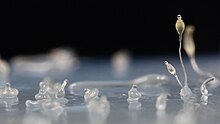Dictyostelid
The dictyostelids are a group of cellular slime molds, or "social amoebae". They are unusual eukaryote organisms. For much of their life they live as separate cells. Then in hard times they come together to reproduce as a fruiting body. The fruiting body produces spores with protective walls. They survive and open up in better times. So these organisms are both unicellular and multicellular.
| Dictyostelids | |
|---|---|

| |
| Dictyostelium discoideum | |
| Scientific classification | |
| Domain: | Eukaryota |
| Phylum: | Amoebozoa |
| Infraphylum: | Mycetozoa |
| Class: | Dictyostelia Lister 1909, emend. Olive 1970 |
| Order: | Dictyosteliida |
| Families & genera | |
|
Dictyosteliidae
| |

As separate amoebae, they feed and divide normally. They mostly eat soil bacteria. When the food supply runs out, they come together to form a kind of slug-like thing. The slug has a definite front and rear. It responds to light and temperature differences, and can move. Under the right conditions the slug becomes a sporocarp (fruiting body). A stalk holds up one or more balls of spores. These spores are inactive cells protected by tough cell walls. They become new amoebae when food is available.
Dictyostelium has been used as a model organism in molecular biology and genetics. It is studied as an example of cell communication, differentiation, and programmed cell death (apoptosis). Research on Dictyostelium is available on-line at dictyBase.[1]

Aggregation in Dictyostelium
changeThe aggregation of the amoebae relies on a signal molecule. One cell, the founder of the colony, begins to secrete the signal in response to stress. Others detect the signal, and respond in two ways:
- The amoeba moves towards the signal.
- The amoeba secretes more signal.
The effect of this is to relay the signal through the nearby population of amoebae. They move to the area of highest signal concentration.
Discovery and classification
changeThey were first discovered in a North Carolina forest in 1935. Dictyostelium discoideum was at first classified under 'lower fungi'.[2] Later it was put in the kingdoms Protista and Fungi. By the 1990s, most scientists accepted the present classification.
Amoebozoa are now regarded as a separate kingdom-level clade, being more closely related to both animals and fungi than to plants.[3]
Genome
changeThe entire genome of Dictyostelium discoideum was published in Nature in 2005.[3] The haploid genome contains about 12,500 genes on six chromosomes. For comparison, the diploid human genome has 20,000–25,000 genes (represented twice) on 23 chromosome pairs.
Sexual reproduction
changeSexual development can occur when amoeboid cells are starved of their bacterial food supply and in the dark.[4][5]
Mating starts by gametogenesis. This produces small, mobile gametes that fuse to form a small binucleate cell. The volume of the binucleate cell then increases to produce a giant binuclear cell. As growth proceeds, the nuclei swell, and then fuse forming a true diploid zygote giant cell. As this is occurring, amoebae undergo chemotaxis towards the giant cell surface. The zygote giant cell ingests the surrounding amoebae, and digests them. Next the zygote forms a macrocyst which stays dormant for a time before germination occurs.[6] When the macrocyst germinates it releases many haploid amoeboid cells.
Model host organism for Legionella
changeDictyostelium shares many molecular features with macrophages. Macrophages are the human host of Legionella. The cytoskeletal composition of D. discoideum is similar to that of mammalian cells. So are the processes driven by these components, such as phagocytosis, membrane trafficking, endocytic transit and vesicle sorting. Like leukocytes, D. discoideum have chemotaxis. Hence, D. discoideum is a suitable model system to see the influence of host cell factors during Legionella infections.[7]
References
change- ↑ "dictyBase". Archived from the original on 2015-03-07. Retrieved 2015-01-30.
- ↑ Cavender J.C.; Spiegl F.; Swanson A. (2002). "Taxonomy, slime molds, and the questions we ask". The Mycological Society of America. 94 (6): 968–979. PMID 21156570.
- ↑ 3.0 3.1 Eichinger L.; et al. (2005). "The genome of the social amoeba Dictyostelium discoideum". Nature. 435 (7038): 43–57. doi:10.1038/nature03481. PMC 1352341. PMID 15875012.
- ↑ Flowers J.M.; et al. (2010). "Variation, sex, and social cooperation: molecular population genetics of the social amoeba Dictyostelium discoideum". PLOS Genet. 6 (7): e1001013. doi:10.1371/journal.pgen.1001013. PMC 2895654. PMID 20617172.
- ↑ O'Day D.H. & Keszei A. (2012). "Signalling and sex in the social amoebozoans". Biol Rev Camb Philos Soc. 87 (2): 313–29. doi:10.1111/j.1469-185X.2011.00200.x. PMID 21929567. S2CID 205599638.
- ↑ Nickerson A.W. & Raper K.B. 1973. Macrocysts in the life cycle of Dictyostelliaceae II. Germination of the macrocysts. Amer. J. Bot. 60(3): 247-254.
- ↑ Bruhn; et al. (2008). "Dictyostelium, a tractable model host organism for Legionella". Legionella: Molecular Microbiology. Caister Academic Press. ISBN 978-1-904455-26-4.
Other websites
change- Dictyostelium (2007)
- dictyBase Online Informatics Resource for Dictyostelium
- dictyBase wiki[permanent dead link] official wiki site for dictyBase
- Dictyostelium discoideum Genome Project Archived 2019-12-06 at the Wayback Machine